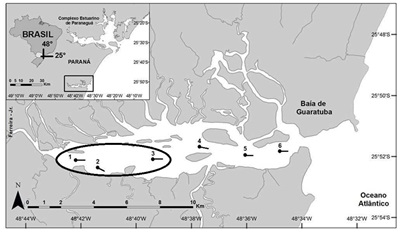Life history traits and population structure of Citharichthys spilopterus (Paralichthyidae): accompanying fauna species in Southern Brazil
DOI:
https://doi.org/10.56926/repia.v3i1.55Keywords:
demersal fish, fishing impact, trawlAbstract
The study aimed to describe life history traits, such as population structure, age, growth, mortality and reproductive biology of the sole Citharichthys spilopterus, in a subtropical estuary in southern Brazil. 275 specimens were captured, obtaining data on total weight, total length, tissue samples and gonad weight. The results showed five stages of gonadal development and split spawning, with reproductive peaks in October and March. The length at first maturation was 10.1 cm for females and 8.0 cm for males, with positive allometric growth. The theoretical maximum length was 17.9 and 15.5 cm, growth coefficient of 0.43 and 0.68 year-1 and longevity of 5.9 and 4.4 years, for females and males respectively. Adult individuals predominated in all collection months, except in May. Total mortality was 1.35 and 2.39 year-1, natural mortality was 1.07 and 1.5 year-1 and fishing mortality was 0.28 and 0.89 year-1, for females and males respectively. The exploitation rate obtained was 0.21 and 0.37year-1, for females and males respectively, allowing us to infer that the species is in an adequate exploitation situation in relation to the stock.
Downloads
References
Andrade, E., Andrade, E., Felizardo, V., Paula, D., Veras, G. & Murgas, L. (2015). Biologia reprodutiva de peixes de água doce. Revista Brasileira de Reprodução Animal, 39(1): 195-201. http://www.cbra.org.br/pages/publicacoes/rbra/v39n1/pag195-201%20(RB573).pdf
Barreto, T., Freire, K., Reis, J., Rosa, L., Carvalho, A. & Rotundo, M. (2018). Fish species caught by shrimp trawlers off the coast of Sergipe, in north-eastern Brazil, and their length–weight relations. Acta Ichthyologica et Piscatoria (2018) 48 (3): 277–283. https://doi.org/10.3750/AIEP/02334
Brown-Peterson, N., Wyanski, D., Saborido-Rey, F., Macewicz, B. & Lowerre-Barbieri, S. (2011). A Standardized terminology for describing reproductive development in fishes. Marine and Coastal Fisheries: Dynamics, Management, and Ecosystem Science, 3:52–70. https://doi.org/10.1080/19425120.2011.555724
Cardoso, O., Pereira A., Oliveira L., Feltrin R. & Spach, H. (2023). Environmental factors in the spatial variability of demersal fish in a subtropical estuary and adjacent continental shelf. Latin American Journal of Aquatic Research, 51(1): 117-132. https://doi.org/10.3856/vol51-issue1-fulltext-2956
Castilhos, B., Huff, T., & Marqueze, A. (2019). Interference of heavy metals present in the water of the Lagoa Tramandaí/ RS on the carbohydrate metabolism of the GURI Sea Catfish (G. genidens) and Bay whiff (C. spilopterus). Comparative Biochemistry and Physiology, Part C, 219:42-49. https://doi.org/10.1016/j.cbpc.2019.01.007
Castillo-Rivera, M. & Kobelkowsky A. (2001). Feeding biology of the Citharichthys spilopterus (Bothidae) in a tropical estuary of Mexico. Journal of Applied Ichthyology 16(2):73 – 78. https://doi.org/10.1046/j.1439-0426.2000.00151.x
Chaves, P. (2022). Juveniles and undersized fish in small-scale fisheries: gillnets are not less implied than trawling. Marine and Fishery Sciences, 35 (2): 165-180. https://doi.org/10.47193/mafis.3522022010501
Costa, E., Ferraz, J. & Murua, H. (2015). Fecundidade em sete espécies de peixes marinhos do atlântico sudoeste. Conference: III Simpósio de Ecologia Reprodutiva. Recuperado de: https://www.researchgate.net/publication/300906445_Fecundidade_em_sete_especies_de_peixes_marinhos_do_atlantico_sudoeste
Dias, J., Fiadi, C., Silbiger, H., & Soares, L. (2005). Reproductive and population dynamics of the Bay whiff Citharichthys spilopterus Günther, 1862 (Pleuronectiformes: Paralichthyidae) in the Mamanguá Inlet, Rio de Janeiro, Brazil. Neotropical Ichthyology, 3(3):411-419. https://doi.org/10.1590/S1679-62252005000300009
Farias, E., Pereira, A., Domingos, M. & Dantas, D. (2019). Proposed bycatch-reduction modifications of shrimp fyke nets used in south american lagoons. Acta Ichthyologica et Piscatoria, 49(1): 1-7. https://doi.org/10.3750/AIEP/02357
Ferraz, J., Bertolucci, C., Nogueira, H. & Soares, L. (2005). Reproductive and population dynamics of the Bay whiff Citharichthys spilopterus Günther, 1862 (Pleuronectiformes: Paralichthyidae) in the Mamanguá Inlet, Rio de Janeiro, Brazil. Neotropical Ichthyology, 3(3):411-419. https://doi.org/10.1590/S1679-62252005000300009
Kobelkowsky, A. & Castillo-Rivera M. (2018). Sexual anatomy of the flounder Citharichthys spilopterus (paralichthyidae). Cybium: International Journal of Ichthyology, 42(2):129-136. https://doi.org/10.26028/CYBIUM/2018-422-001
Oliveira, E. & Fávaro, L. (2011). Reproductive biology of the flatfish Etropus crossotus (Pleuronectiformes: Paralichthyidae) in the Paranaguá Estuarine Complex, Paraná State, subtropical region of Brazil. Neotropical Ichthyology, 9(4): 795-805. https://doi.org/10.1590/S1679-62252011005000043
Pauly (1980). On the interrelationships between natural mortality, growth parameters, and mean environmental temperature in 175 fish stocks. J. Cons. int. Explor. Mer, 39(2). https://academic.oup.com/icesjms/article/39/2/175/647984?login=false
Penha, A., Gerson, F. & Costa, M. (2004). Estratégia trófica dos linguados Citharichthys spilopterus Günther e Symphurus tessellatus (Quoy & Gaimard) (Actinopterygii, Pleuronectiformes) na Baía de Sepetiba, Rio de Janeiro, Brasil. Revista Brasileira de Zoologia, 21(4):857-864. https://doi.org/10.1590/S0101-81752004000400020
Possamai, B. & Fávaro, L. (2015). Using mariculture as a breeding site: reproduction of Hypleurochilus fissicornis (Actinopterygii: Blenniidae). Environmental Science, Biology. https://doi.org/10.3989/SCIMAR.04176.19B
Pusceddu, A., Bianchelli, S., Martin J., Puig, P., Palanques, A., Masque, P. & Danovaro, R. (2014). Chronic and intensive bottom trawling impairs deep-sea biodiversity and ecosystem functioning. Proceedings of the National Academy of Sciences of the United States of America, 111(24): 8861–8866. https://doi.org/10.1073/pnas.1405454111
Sanchez-Gil, P., Yáñez-Arancibia, A., Tapia, M., Day, J., Wilson, C.A. & Cowan Jr., J. (2008). Ecological and biological strategies of Etropus crossotus and Citharichthys spilopterus (Pleuronectiformes:Paralichthyidae) related to the estuarine plume, Southern Gulf of Mexico. Journal of Sea Research, 59: 173–185. https://doi.org/10.1016/j.seares.2007.12.002
Santos, R., Silva, J., Costa, M. & Araújo, F. (2015). O tamanho de primeira maturação como parâmetro para o estabelecimento de tamanho mínimo de captura para corvina no sudeste do Brasil. Boletim Instituto de Pesca, 41(3): 507-518.
Toepfer, C. & Fleeger, J. (1995). Diet of Juvenile Fishes Citharichthys Spilopterus, Symphurus Plagiusa, and Gobionellus Boleosoma. Bulletin of Marine Science, 56(1):238-249. Recuperado: https://www.ingentaconnect.com/contentone/umrsmas/bullmar/1995/00000056/00000001/art00015?crawler=true
Vazzoler, A. (1981). Manual de métodos para estudos biológicos em populações de peixes. Reprodução e crescimento. Programa Nacional de Zoologia. Brasília, CNPq.106p.
Vazzoler AEM. (1966). Biologia da reprodução de peixes teleósteos: teoria e pratica. Ed., Universidade Estadual de Maringá, 169pp.
Zanlorenzi, D. (2016). Caracterização das assembléias de peixes demersais e suas relações com um gradiente ambiental em um estuário subtropical brasileiro. Tese para título de doutor, Universidade Federal do Paraná, Brasil. https://www.iat.pr.gov.br/sites/agua-terra/arquivos_restritos/files/documento/2020-12/projeto_456_2012.pdf
Zárate-Hernández, R., Castillo-Rivera, M., Sanvicente-Añorve L. & Ortiz-Burgos S. (2012). Spatial, diel, and seasonal changes in the fish community structure of a Mexican tropical estuary. Ciencias Marinas, 38(4): 665-676. https://doi.org/10.7773/cm.v38i4.2018

Published
How to Cite
Issue
Section
License
Copyright (c) 2024 Sybill Prisyla Casado-del-Castillo, Luis Fernando Fávaro

This work is licensed under a Creative Commons Attribution 4.0 International License.
Authors retain their rights:
a. The authors retain the intellectual property rights (copyright) of the published works, assigning to the journal the right of first publication.
b. Authors retain their trademark and patent rights, and also on any process or procedure described in the article.
c. Authors retain the right to share, copy, distribute, perform and publicly communicate the article published in REPIA (e.g., place it in an institutional repository or publish it in a book), with an acknowledgement of its initial publication in REPIA.
d. Authors retain the right to make a subsequent publication of their work, to use the article or any part of it (e.g., a compilation of their work, notes for conferences, theses, or for a book), provided they indicate the source of publication (authors of the work, journal, volume, number, and date).







